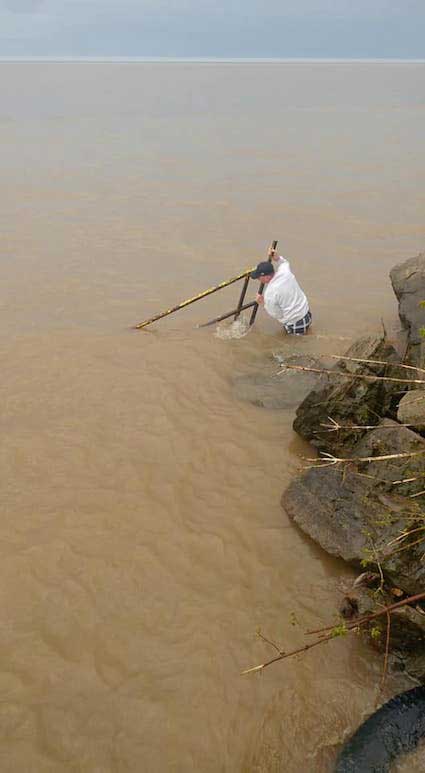Governor declares state of emergency along Lake Ontario
NY appeals to IJC to let out more water

Photo courtesy of Nicole Bellnier: Ed Bellnier tries to save the steps that led to the deck at his home along Lake Ontario in Point Breeze on Monday.
Press Release, Gov. Cuomo’s Office
Governor Cuomo today declared a State of Emergency for the following counties in order to expedite repair to impacted structures and construction of shoreline stabilization projects: Cayuga, Jefferson, Monroe, Niagara, Orleans, Oswego, St. Lawrence, and Wayne.
The Governor’s order empowers the Department of Environmental Conservation and other state agencies to issue emergency individual permits for those larger-scale response actions that may be necessary.
Cuomo also announced the deployment of 20 members of the National Guard and a coordinated Lake Ontario Rapid Response Team, including experts from the DEC, the Division of Homeland Security and Emergency Services, National Guard, State Police and Office of General Services, along with city and county agencies.
At the Governor’s direction, 365,000 sandbags have been deployed to the region and are ready for placement in lower elevation areas. The deployments by county are as follows: 60,000 for Niagara County, 30,000 for Orleans County, 115,000 for Wayne County, 50,000 for Jefferson County, 30,000 for Oswego County and 80,000 to Monroe County. Five sandbaggers have also been deployed to Niagara, Monroe and Wayne Counties.
The Governor also announced that the State is formally appealing to the International Joint Commission to release additional water through the Moses-Saunders Dam to lower Lake Ontario water levels and protect impacted communities. The IJC is a bi-national organization established by the federal governments of the United States and Canada under the Boundary Waters Treaty of 1909, regulates Lake Ontario-St. Lawrence River water levels by controlling water releases through the Moses-Saunders Dam located on the St. Lawrence River between Cornwall, Ontario and Massena, New York.
In addition, the Governor has launched a Lake Ontario Flood Assistance Hotline to provide the latest information to residents affected in their community at 866-244-3839. Residents can call the hotline for the latest flooding forecast, help with flood mitigation measures like sandbags, or for technical assistance regarding on-site repairs.
“With waters on the Lake Ontario coastline rising to the highest levels in 20 years, we are remaining vigilant and will continue to do everything in our power to assist communities with flooding preparation and response measures,” Cuomo said.
DHSES has been in constant communication with county emergency management officials in the region. The New York State Police assets are ready for deployment as needed and troopers are on high alert and instructed to closely monitor flood prone areas for rising waters while on patrol. Two high axle vehicles with zodiac boats and an additional sandbagger has been pre-positioned at DHSES Chili Stockpile, and the Stockpile is also fully stocked with generators, light towers, pumps, hoses and barriers which can be deployed as necessary.
As part of the Lake Ontario Rapid Response Team, DEC is deploying a team of experienced coastal engineers to Lake Ontario to work with property owners to address erosion, conduct site visits, meet with owners, and offer technical guidance. The team will rapidly review all emergency permit applications received. DEC’s engineers stand ready to work with property owners so that protective structures can be repaired and homeowners can take appropriate actions expeditiously. Property owners can contact DEC’s Division of Water at 518-402-8185 or coastals@dec.ny.gov.
As of April 27, Lake Ontario levels rose about 25 inches since the beginning of April, reaching 247.7 feet, which is over 20 inches above the seasonal average. The current Army Corp of Engineers Lake Level forecast indicates that the lake may rise an additional 3 inches through May 28, 2017. The coastal communities of Lake Ontario are at particular risk from wind-driven waves and even higher water elevations from storm surge. Many towns have declared a state of emergency.
Department of Environmental Conservation Commissioner Basil Seggos said, “With increased precipitation and rapid snow melt, record water flows through major tributaries upstream and downstream of the lake, water is high throughout the Great Lakes system. The Governor has directed DEC to take strong actions now to assist local communities and residents with erosion and flooding issues. The State of Emergency and associated actions announced today will reduce flood risk and help speed recovery.”





































































